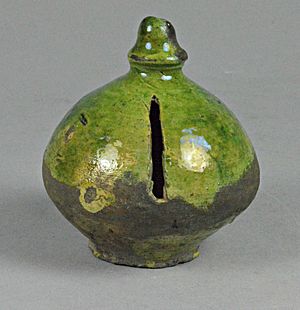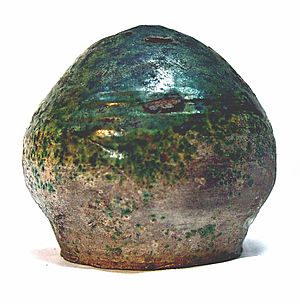Tudor money box facts for kids
A Tudor money box was a special kind of pot used a long time ago in Britain. People used these small, strong pots to save their money. They were like a portable bank! These pots were usually round and sealed. They had a narrow slot to put coins in. Many theatres during the Elizabethan era used them to collect money from people buying tickets. Once a money box was full, you had to break it to get your money out.
Contents
What Did Tudor Money Boxes Look Like?
These small ceramic money boxes were usually round. By the 1500s, some had a top that looked like a bell and got narrower at the very top. The pot was completely sealed. It had a thin slot on the side where you could drop coins in.
How Were They Made?
These glazed pots were made in places like Surrey and near the Surrey-Hampshire borders in England. Each pot was made from a type of clay called earthenware. Then, they were decorated with a special colored glaze. This glaze was known as "Tudor Green."
The "Tudor Green" Color
The unique green color came from adding powdered copper to a clear glaze. The final color of the pot could be dark green or yellow-green. This depended on the color of the clay and how thick the glaze was.
When Were Tudor Money Boxes Used?
Tudor money boxes were used in Britain from the 1300s to the 1600s. They were a cheap way to collect and save money. During the Elizabethan era, theatres in London and nearby areas used them. They collected ticket money from people coming to see plays.
Getting Money Out
When a money pot was full, the only way to get the coins out was to break the pot. This meant the pot was destroyed after it served its purpose.
Finding Old Money Boxes Today
Archaeologists have found many pieces of these money boxes. For example, in 1988 and 2010, the Museum of London Archaeology (MOLA) found many broken pieces. They found them at the site of the Elizabethan Rose Theatre in London. Finding a whole, unbroken Tudor money box is very rare today!
See also
- Christmas box
- Piggy bank
- Poor box



